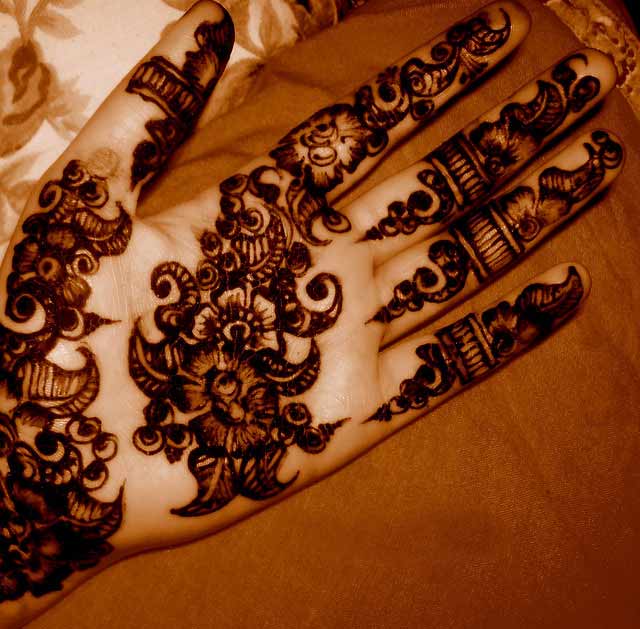Bridal Mehandi Designs 2013-2014 Biogarphy
Source(google.com.pk)
The word Henna has its origin in the Arabic word Al-Hinna. In botanical terms it is Lawsonia Enermis, a plant which grows to be 4 to 8 feet high in hot climates and can be found in Iran, Pakistan, Syria, Persia, Morocco, Palestine, Yemen, Egypt, Uganda, Tanzania, Afghanistan, Senegal, Kenya, Ethiopia, Eritrea, and India. The leaves, flowers and the twigs of the plant are ground into fine powder containing natural dying properties called tannins; the powder is then mixed with hot water
The earliest evidence of the cosmetic use of henna is from ancient Egypt. It was common practice among the Egyptians to dye their fingernails a reddish hue with henna, and it was considered ill-mannered not to do so. Traces of henna have been found on the hands of Egyptian mummies up to five thousand years old.
While henna is known by many names including Henne, Al-Khanna, Jamaica Mignonette, Egyptian Privet and Smooth Lawsonia, the art of its application is referred to as Henna (Arabic) or Medhi (Hindu).
Mehndi is the Indian name for the plant and the body art associated with its use. Intricate designs were painted on new brides and as part of the marriage ceremony in India. It is associated with the transition into womanhood and a celebration of marriage. It features prominently in some ancient tales, including as warn by Parvati, Lord Shiva's wife, to charm her difficult to please husband. In Morocco henna is considered magical and is used in the transformation of man and woman into husband and wife.
Throughout time henna has been associated with special celebrations. Betrothals, weddings, the eighth month of pregnancy, the birth, the 40th day after a woman gives birth, naming ceremonies, circumcisions, etc, are all events celebrated with henna. Eids, and other religious holidays are also occasions to be hennaed. There are also some healing ceremonies, like the Zar in North Africa, which include its use. A common practice seen in India and in the Islamic world is the pre-wedding tradition of 'Night of Henna' parties.
Used to pay homage to the body, cosmetics and perfumes were also essential to the Indian woman, whose duty it was to appear alluring to her lover. Staining the nails, skin and hair with henna is the favorite way of enhancing beauty amongst women in the Middle East also. In the famous Indian treatise on love, the Kama Sutra (compiled between 100 and 600 C.E.) women are advised to learn the arts of tattooing and of "coloring the teeth, garments, hair, nails, and bodies." Cosmetics also served as an emblem of class rank or caste; the placement of facial adornments separated the upper castes from the lower. Many Indian women still use cosmetics in the ancient way; eyelids are tinted with an antimony-based dye, the face and arms are stained yellow with saffron powder, and the soles of the feet are reddened with henna.
Bridal Mehandi Designs Photos Pictures Pics Images2013-2014

Bridal Mehandi Designs Photos Pictures PicsImages 2013-2014

Bridal Mehandi Designs Photos Pictures Pics Images 2013-2014

Bridal Mehandi Designs Photos Pictures Pics Images 2013-2014

Bridal Mehandi Designs Photos Pictures Pics Images 2013-2014

Bridal Mehandi Designs Photos Pictures Pics Images 2013-2014

Bridal Mehandi Designs Photos Pictures Pics Images 2013-2014

Bridal Mehandi Designs Photos Pictures Pics Images 2013-2014

Bridal Mehandi Designs Photos Pictures Pics Images 2013-2014
No comments:
Post a Comment